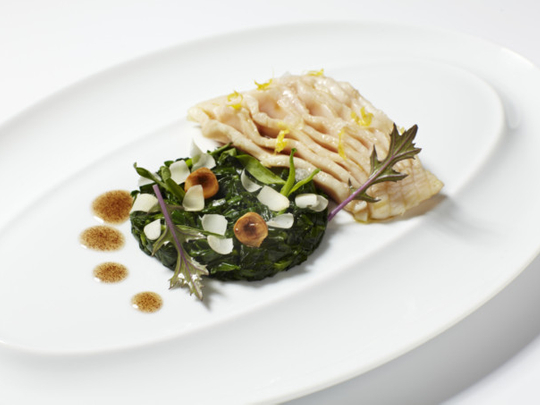
Knödel, bratkartoffeln, sauerbraten, spätzle, and wiener schnitzel. If you ask a German expatriate in the UAE about typical German fare, chances are they’ll answer with one of the above or with an equally popular dish from childhood. Ask about new German cuisine and you’ll most likely receive the response, “Is there even such a thing?”, as Christian Rödel, a 33-year-old German who has lived in Dubai for almost eight years, puts it. This is hardly surprising as a handful of German restaurants in the city feature stodgy staples on the menu, such as weisswurst, sauerkraut and most likely a Teutonic take on the humble potato salad.
While a German food renaissance in this region is fairly far off, the opposite is occurring in Germany right now, with a brigade of classically trained yet determined chefs acting as the vanguard towards something exciting, and in the process, ushering in a new age of German cuisine.
In the 2013 Michelin Red Guide — the oldest and best-known European hotel and restaurant reference that issues one, two and three stars for restaurants of excellent quality — Germany was only second to France, with 311 stars across 255 restaurants. Today, there are more than ten three-star restaurants and more than 30 with two Michelin stars. The guide’s editor, Ralf Flinkenflügel even described it as the “golden generation of young chefs”. But, what is today’s German cuisine all about? Up-and-coming chef, Tohru Nakamura of German-Japanese background, who is also rumoured to be pegged with his first Michelin star later this year, describes it simply as “craftsmanship, perfection and quality”. A leitmotif also shared by two-star Michelin chef de cuisine Christoph Rüffer of the newly refurbished Haerlin restaurant in Hamburg, who sees this as “[taking] very classical recipes and interpreting them in a modern way”. He cites the traditional northern German fish dish as an example, but updated à la meunière, complete with a lightness of parsley and almond cream.
By contrast, Christian Bau, another top Michelin star chef (three-star) believes that it has nothing to do with traditional fare, but can be explained instead by a more sophisticated palate and a consciousness towards healthier cuisine among a growing number of the population. Semantics aside and whether new German cuisine is reminiscent of 1960s throwback nouvelle cuisine, refined rustic or even on the cusp of the molecular movement, the spirit towards advancing the food experience is one that is shared by these chefs and others like them across the country.
“Germans will always be quality freaks, whether they like it or not,” says Dirk Haltenhof, Executive Chef at The Oberoi, Dubai. “It’s in their genes.” He believes that the country’s apprenticeship programme builds a strong base for the talented chef to start off from, in addition to developing speciality trades within the craft, such as bakers, butchers and pastry chefs. Reality TV personality and acclaimed chef Frank Oehler reaffirms that today’s chef has more knowledge, intelligence and eloquence, which, collectively speaking, has propelled the profession in recent years. Oehler and his peers altered the culinary landscape more than a decade ago by adopting practices combined with a light-hearted approach towards modern cookery.
Strong regional cuisine
Nakamura points to the fact that unlike other countries, such as Spain with its more avant-garde route or northern Europe and its emphasis on strong regional cuisine, today’s German chef is both knowledgeable and comfortable with the fundamentals, and can perfectly poach a fish and set up a classical sauce structure, while still pushing the boundaries in creative gastronomy.
Talent and training are only part of the equation. Bau suggests that increased profitability and the diversity of products within the country are the key. Sourcing indigenous ingredients is less expensive when compared to France and these savings are reflected on the menus and ultimately down to the consumer. Combined by the sheer number of one-Michelin-star restaurants in Germany, totaling 187, the dining scene has never been more affordable for the average person.
During this year’s S. Pellegrino awards ceremony, the award for Best Chef in Germany was awarded to three pioneers in the field — Harold Wohlfahrt, Helmut Thieltges and Joachim Wissler. “Harold Wohlfahrt looked over my shoulder when I had my final exam in his Schwarzwaldstube Restaurant,” says Haltenhof. Nakamura studied under Joachim Wissler, lauded for coining the term ‘neue deutsche Küche’ (new German cuisine) at his celebrated Vendôme Restaurant.
Ground reality
Moreover, television programmes beginning in the late 1980s with Essen wie Gott in Deutschland (Eat Like a God in Germany), which coincidentally was the reason Rüffer went into the kitchen, to today’s Die Kochprofis (The Cooking Professionals), the country’s answer to Ramsey’s Kitchen Nightmares, have created a groundswell of support for a profession that has recently become popular. However, despite these chalked-up credentials, why is it that 80 per cent of the population continue to regard the beloved currywurst as part of their diet with almost a billion being consumed every year? Added to this is the fact that Germans are known still as the Europeans who spend particularly little money on food and drink.
This then begs the question — will Teutonic pride on the food front ever match or succeed that of its A-list rivals? If the accounts of the chefs mentioned in this article is anything to go by, the future looks promising for modern German gastronomy.
— Special to GN Focus


